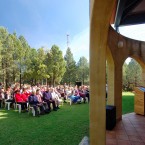Explore places associated with the history of Italian migration, settlement and horticulture in Griffith, the regional centre of the Murrumbidgee Irrigation Area – famous for its wine, citrus and stone fruit industries.
”It has been a major undertaking and we’re really pleased with the results each stage has produced,” she said.
The completed trail includes 12 historically significant sites to Griffith, which will be identified by a plaque at an appropriate location near the building or area at a later date.
A Italian Migration Heritage Trail brochure is a pictorial guide that chronicles the history of Italian settlers and includes written accounts of the significance of each feature.
President of the Italian Museum and Cultural Centre Frank Perosin said the project was an important tribute to the Italian settlers who helped establish the region.
”It can only be a good thing to record and acknowledge the effort that the Italians made in helping to establish this area and it will be there for future generations to learn from,” he said.
The 12 sites chosen for inclusion are the Dethridge Wheel, Tom’s Supermarket, the Broadway Store, P & C Calapari Boot Repairs, Belvedere Pizza and Gelati Restaurant, Colla Bros General Blacksmiths, Salon Battaglia, Continental Music Club, Coronation Hall and the Italo-Australian Club, Our Lady of Pompeii Church, Yoogali Club and the site of the first soccer game in 1950.


